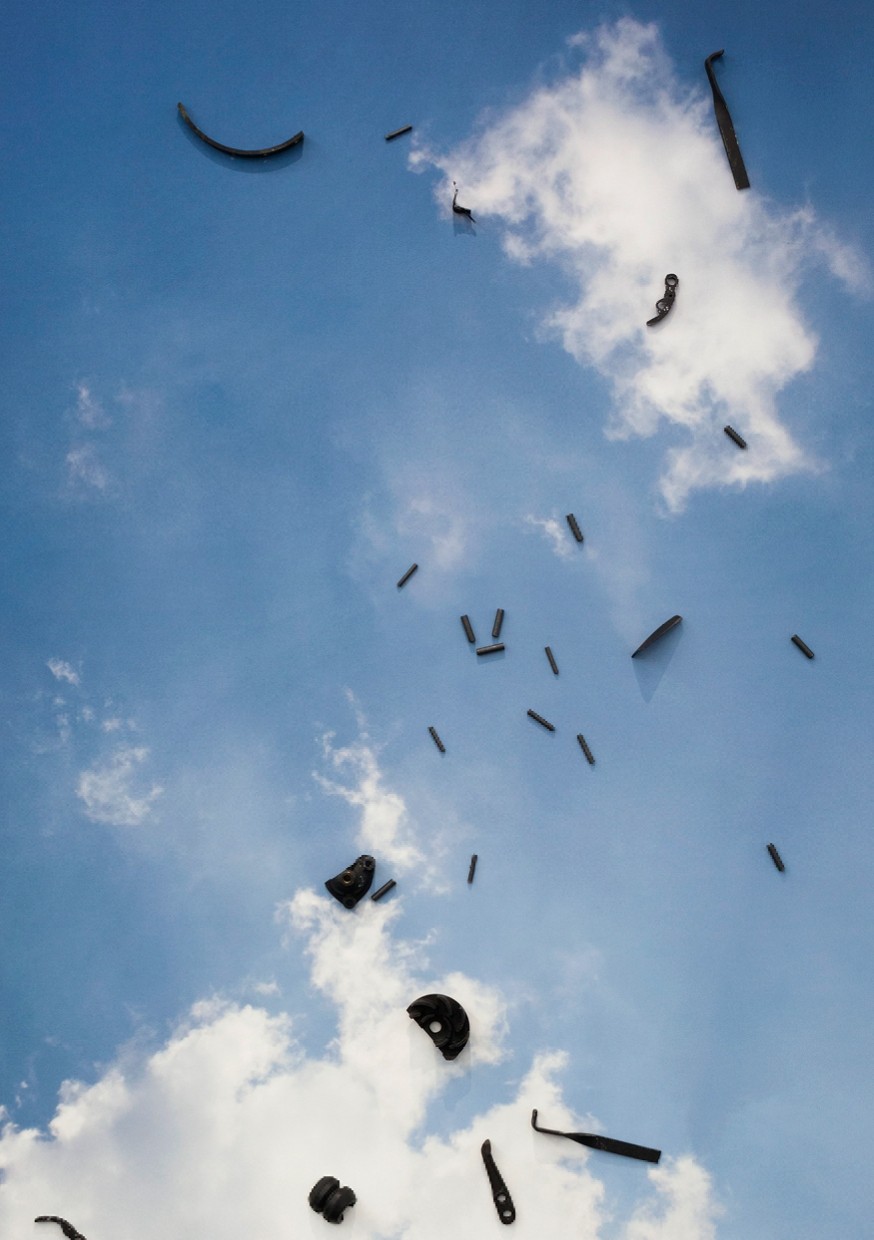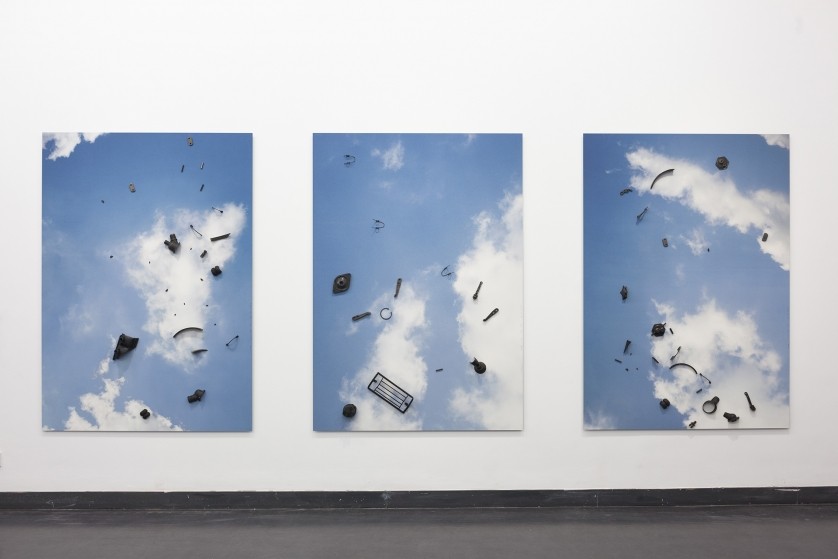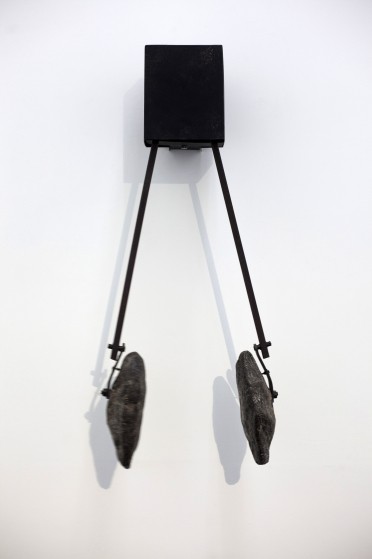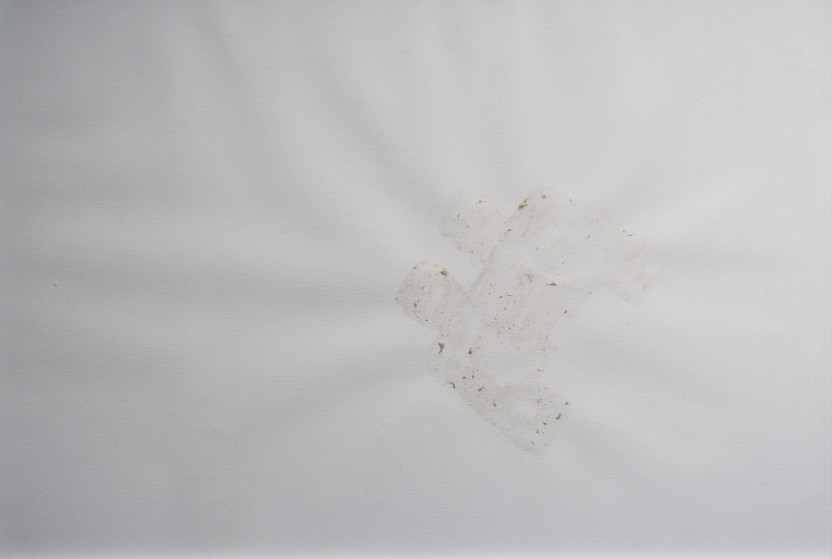Shilpa Gupta
Drawing In The Dark
21 Oct 2017 - 18 Feb 2018

Unnoticed, 2007, C-print mounted on dibond, fragmented spare motor parts, 123 x 172 cm.
Courtesy : Shilpa Gupta et Galerie CONTINUA, San Gimignano / Beijing / Les Moulins / Habana
Photo : Tom Callemin.
Courtesy : Shilpa Gupta et Galerie CONTINUA, San Gimignano / Beijing / Les Moulins / Habana
Photo : Tom Callemin.

1:2138, 2017, vitrine, plaque de laiton, tissu, 56 x 51 x 157,5 cm.
Courtesy : Shilpa Gupta et Galerie CONTINUA, San Gimignano / Beijing / Les Moulins / Habana. Photo : Tom Callemin.
Courtesy : Shilpa Gupta et Galerie CONTINUA, San Gimignano / Beijing / Les Moulins / Habana. Photo : Tom Callemin.

24:00:01, 2017, flapboard, 177x25x28 cm.
Courtesy : Shilpa Gupta et Dvir Gallery. Photo : Tom Callemin. Vue de l'exposition à KIOSK, Gand, Belgique.
Courtesy : Shilpa Gupta et Dvir Gallery. Photo : Tom Callemin. Vue de l'exposition à KIOSK, Gand, Belgique.

Unnoticed, 2017, C-print monté sur dibond, fragments de pièces automobiles 123 x 172 cm.
Courtesy : Shilpa Gupta et Galerie CONTINUA, San Gimignano / Beijing / Les Moulins / Habana. Photo : Tom Callemin. Vue de l'exposition à KIOSK, Gand, Belgique.
Courtesy : Shilpa Gupta et Galerie CONTINUA, San Gimignano / Beijing / Les Moulins / Habana. Photo : Tom Callemin. Vue de l'exposition à KIOSK, Gand, Belgique.

Song of the Ground, 2017, système mécanique, 79 x 22 x18 cm.
Courtesy : Shilpa Gupta et Galerie CONTINUA, San Gimignano / Beijing / Les Moulins / Habana. Photo : Tom Callemin. Vue de l'exposition à KIOSK, Gand, Belgique.
Courtesy : Shilpa Gupta et Galerie CONTINUA, San Gimignano / Beijing / Les Moulins / Habana. Photo : Tom Callemin. Vue de l'exposition à KIOSK, Gand, Belgique.

Untitled, 2017, papier, pigment extrait de marijuana, 29,2 x 42 cm.
Courtesy : Shilpa Gupta et Galerie CONTINUA, San Gimignano / Beijing / Les Moulins / Habana. Photo : Tom Callemin.
Courtesy : Shilpa Gupta et Galerie CONTINUA, San Gimignano / Beijing / Les Moulins / Habana. Photo : Tom Callemin.
SHILPA GUPTA
Drawing In The Dark
21 October 2017 – 18 February 2018
Indian artist Shilpa Gupta presents the solo exhibition Drawing in the Dark. The title refers to the clandestine movements and practices in borderlands, and to the metaphor of the line or threshold that links several of the works on display here.
The show is part of Gupta’s ongoing investigation into interrelations between structures, specifically those of the state and the individual, and their rescaling as encountered, at what is both frontier and periphery. Continuing her six years of ongoing research – specifically in the borderlands of India and Bangladesh – this new series of works is an extension of the My East is Your West project she developed for the 2015 Venice Biennale. In late 2016 Gupta returned to parts around the border fence that India is building, encircling its neighbor Bangladesh and that is notorious for being the world’s longest separation barrier under construction between two nation states. However, says the artist, “daily life in the borderland belies state intentions and the flows of people and goods continue, prompted by historical and social affinities, geographical continuity and economic imperative”.
Accompanying the central sculpture 24:00:01 (motion flapboard, 2010 -12) are a series of new pieces which can be seen as a collection of clandestine stories. The drawings, photos and sculptures draw a picture of the subversive, illegal and informal stream of goods, people and desires. An object wound with a shredded Dhakai Jamdani saree (traditional clothing), drawings made with marijuana and photo collages with spare motor parts carry narratives of unlisted journeys over a meandering map line.
What Gupta’s work aims to provoke in the visitor, rather than a passive aesthetic experience, are questions. She initiates a dialogue on the perception and construction of identity, and on those notions that exercise an influence over these processes: nationality, technology, religion, borders, conflicts, control or censorship: “I am interested in perception and therefore, with how definitions get stretched or trespassed, be it by gender, beliefs, or the notion of a nation. There exists a chasm between the larger construct which seeks singularity, and its own fragment which may not. Markings and measuring, seemingly logical acts may not necessarily provide solutions” (Shilpa Gupta in Indian Express, 2016).
In the borderlands Gupta evokes with Drawing in the Dark, our apparently rigorous laws reveal themselves as in constant motion and subject to debate. The fringe area is shown as a stretch of no man’s land where practices and narratives develop “in the dark”, or as a parallel circuit of goods that operates “invisibly” before the authorities’ eyes. The “law” of each identity is replaced here by a set of conditional rules, freeing up mental and experimental space in which to question ourselves.
Drawing In The Dark
21 October 2017 – 18 February 2018
Indian artist Shilpa Gupta presents the solo exhibition Drawing in the Dark. The title refers to the clandestine movements and practices in borderlands, and to the metaphor of the line or threshold that links several of the works on display here.
The show is part of Gupta’s ongoing investigation into interrelations between structures, specifically those of the state and the individual, and their rescaling as encountered, at what is both frontier and periphery. Continuing her six years of ongoing research – specifically in the borderlands of India and Bangladesh – this new series of works is an extension of the My East is Your West project she developed for the 2015 Venice Biennale. In late 2016 Gupta returned to parts around the border fence that India is building, encircling its neighbor Bangladesh and that is notorious for being the world’s longest separation barrier under construction between two nation states. However, says the artist, “daily life in the borderland belies state intentions and the flows of people and goods continue, prompted by historical and social affinities, geographical continuity and economic imperative”.
Accompanying the central sculpture 24:00:01 (motion flapboard, 2010 -12) are a series of new pieces which can be seen as a collection of clandestine stories. The drawings, photos and sculptures draw a picture of the subversive, illegal and informal stream of goods, people and desires. An object wound with a shredded Dhakai Jamdani saree (traditional clothing), drawings made with marijuana and photo collages with spare motor parts carry narratives of unlisted journeys over a meandering map line.
What Gupta’s work aims to provoke in the visitor, rather than a passive aesthetic experience, are questions. She initiates a dialogue on the perception and construction of identity, and on those notions that exercise an influence over these processes: nationality, technology, religion, borders, conflicts, control or censorship: “I am interested in perception and therefore, with how definitions get stretched or trespassed, be it by gender, beliefs, or the notion of a nation. There exists a chasm between the larger construct which seeks singularity, and its own fragment which may not. Markings and measuring, seemingly logical acts may not necessarily provide solutions” (Shilpa Gupta in Indian Express, 2016).
In the borderlands Gupta evokes with Drawing in the Dark, our apparently rigorous laws reveal themselves as in constant motion and subject to debate. The fringe area is shown as a stretch of no man’s land where practices and narratives develop “in the dark”, or as a parallel circuit of goods that operates “invisibly” before the authorities’ eyes. The “law” of each identity is replaced here by a set of conditional rules, freeing up mental and experimental space in which to question ourselves.
